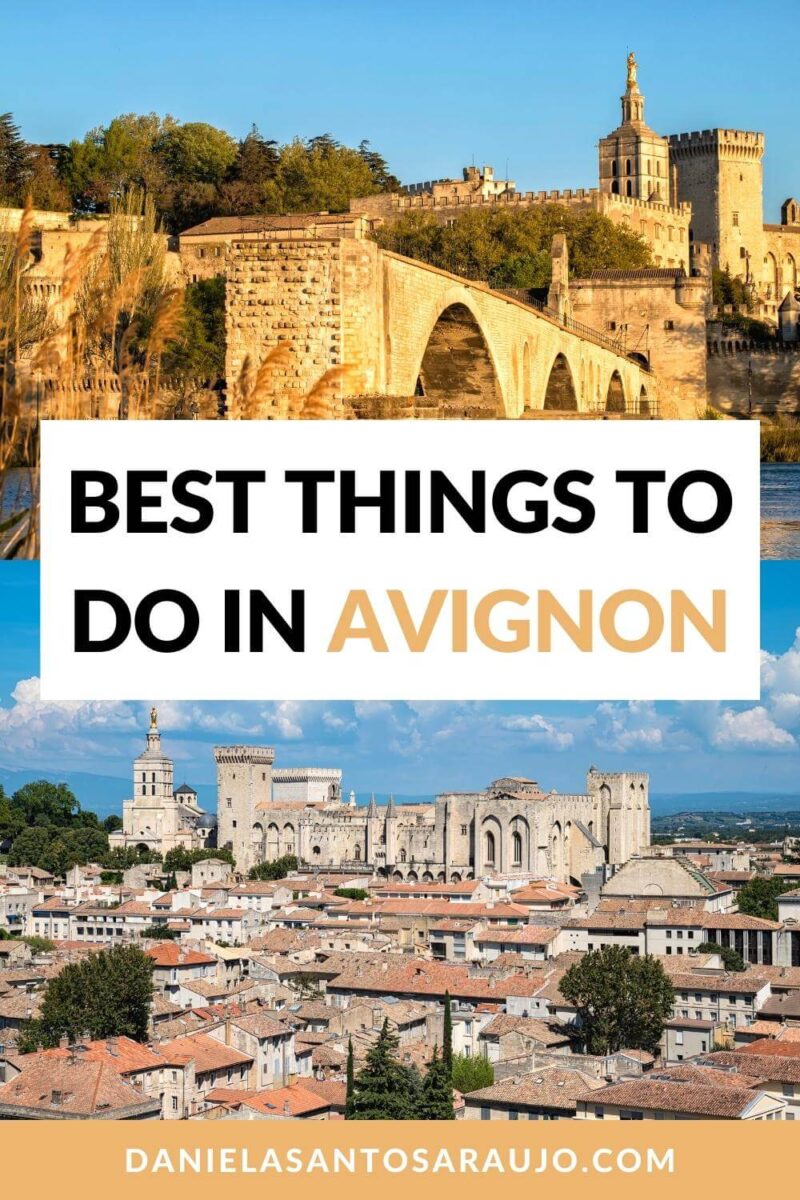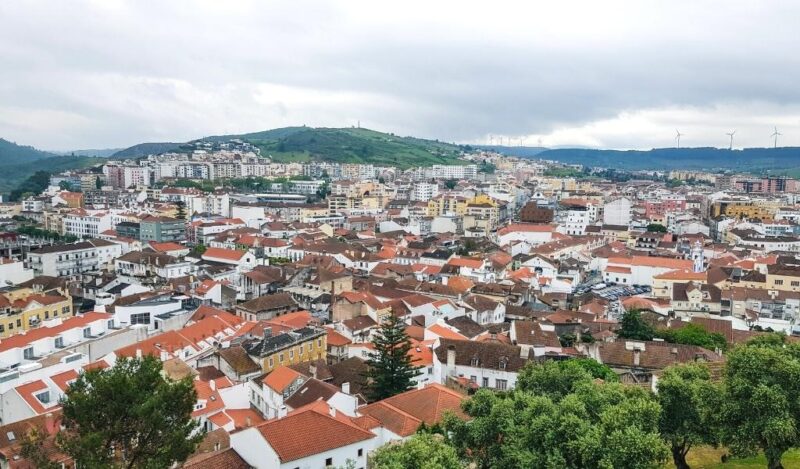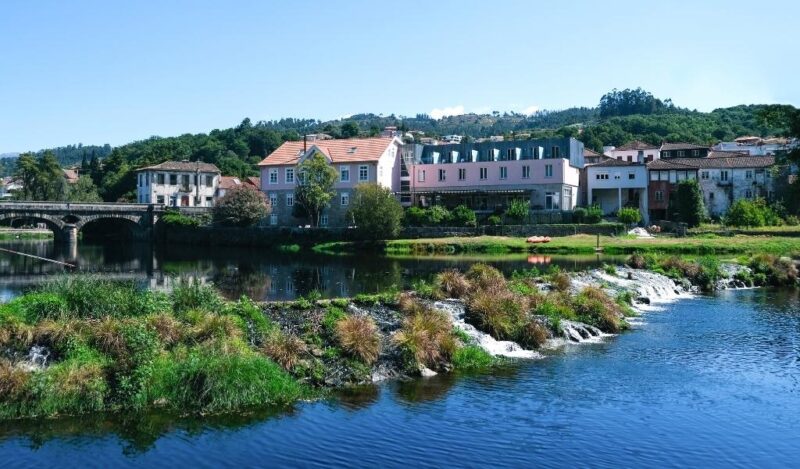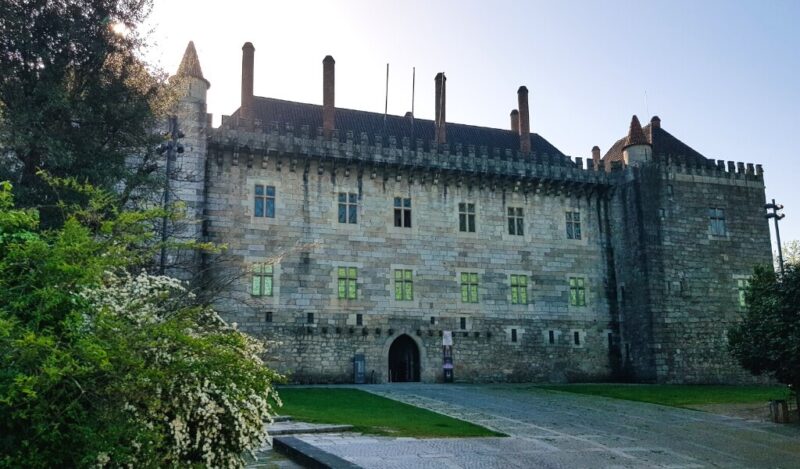Did you know that Avignon is the second oldest city in France, right after Marseille? Located in the south of the country, more specifically in the Provence-Alpes-Côte d’Azur region, Avignon is the perfect starting point for a trip to the famous lavender fields in Provence!
On this Avignon itinerary, you’ll have the opportunity to discover numerous interesting museums and fascinating religious temples, as well as iconic monuments in the historic center (such as the Papal Palace, the Episcopal Ensemble, and the Avignon Bridge, which have been a UNESCO World Heritage Site since 1995)!
So, do you want to know more about 1 Day In Avignon: The Perfect Avignon Itinerary? Keep reading!
This post may contain affiliate links, meaning I earn a small commission if you make a purchase, at no additional cost to you. Please read my disclosure & privacy policy for more information.
No time to read now? Pin it for later!


Brief History of Avignon
The occupation of the site where Avignon is today dates back to the Neolithic period, as evidenced by several archaeological excavations. But its history as a city began with the Greeks, who established a trading port here in the 6th century BC, which they designated by Aouenion.
In the first half of the 2nd century AD, the Greek emporium of Aouenion passed into the domain of the Roman Empire and was renamed Avennio. And when Emperor Hadrian visited the region, he gave Avennio the status of a Roman colony, with the title of Colonia Julia Hadriana Avenniensis.

However, the most important era in Avignon’s history took place between 1309 and 1423, when it became the official residence of the Popes. In all, seven Popes lived in Avignon until 1377, which is why this period is known as the Avignon Papacy, and the city is still called the “City of Popes” today.
Avignon remained a papal property until 1791, the year in which the French Revolution was happening and the city was annexed to France. These days, it’s one of the few destinations in the country with its walls and historic center so well preserved. For that reason, Avignon was inscribed as a UNESCO World Heritage Site in 1995.
World Heritage
Did you know that the Historic Center of Avignon: Papal Palace, Episcopal Ensemble and Avignon Bridge were part of France’s ninth set of inscriptions on the UNESCO World Heritage List? This 19th session of the World Heritage Committee took place in Berlin (Germany), between December 4th and 9th, 1995.
Nowadays, France is the third country in the world and the second country in Europe with the most UNESCO sites, tied with Germany. It has fifty-two heritage assets (both cultural and natural) inscribed on the world list of the United Nations Educational, Scientific, and Cultural Organization!
In the meantime, I’ve already had the opportunity to visit nine of them:
- Castle of Sully-sur-Loire (2000)
- Historic Center of Avignon: Papal Palace, Episcopal Ensemble and Avignon Bridge (1995)
- Le Havre, the City Rebuilt by Auguste Perret (2005)
- Mont Saint-Michel and its Bay (1979)
- Nice, Winter Resort Town of the Riviera (2021)
- Palace and Park of Fontainebleau (1981)
- Palace and Park of Versailles (1985)
- Paris, Banks of the Seine (1991)
- Provins, Town of Medieval Fairs (2001)
Visiting Avignon
Due to its excellent geographical location, there are two recommended ways to explore Avignon: on a day trip from Marseille (100 km by car and 30 minutes by TGV train) or Montpellier (100 km by car and 1h30 by TER train), or a road trip through the south of France.
If you prefer the second option, I think you should consider visiting other cities and towns in the vicinity: Orange (30 km by car and 15 minutes by train), Arles (40 km by car and 20 minutes by train), Nîmes (45 km by car and 30 minutes by train), and Aix-en-Provence (85 km by car) – and, of course, Marseille and Montepellier.

It’s also possible to travel to/from Avignon by bus, with Flixbus!
Avignon Itinerary
Remparts d’Avignon
The Walls of Avignon (in French, Remparts d’Avignon) are one of the best examples of fortified fences still existing in France.
With more than 4 km long and about 8 meters high, the walled enclosure of the old city was built between 1355 and 1370, during the pontificates of Innocent VI and Urban V.

When they were completed in the middle of the Hundred Years’ War, the Walls of Avignon were protected by 35 main towers, 50 secondary towers, 7 doors with drawbridge, and a moat 4 meters deep!
In this Avignon itinerary, I suggest that you enter the old city through the Porte de la République, right in front of the Gare d’Avignon Centre.
Collection Lambert
Approximately 300 meters from the Porte de la République, you’re going to find the Lambert Collection (in French, Collection Lambert), a contemporary art museum founded by art collector Yvon Lambert. Opened in 2000, the art gallery is housed in two 18th-century buildings in the historic center of Avignon: the Hôtel de Caumont (for the permanent exhibition) and the Hôtel de Montfaucon (for temporary exhibitions).
With hundreds of works from the second half of the 20th century and the beginning of the 21st century, the Lambert Collection includes artists such as Cy Twombly, Sol LeWitt, Robert Ryman, Niele Toroni, Daniel Buren, Lawrence Weiner, Christian Boltanski, Bertrand Lavier, Andres Serrano, Nan Goldin, Miquel Barceló, Mirosław Bałka, Jean-Michel Basquiat, Douglas Gordon, Adel Abdessemed and Francesco Vezzoli.
The Lambert Collection is open from Tuesday to Sunday, from 11 am to 6 pm (September to June), and every day from 11 am to 7 pm (in July and August). Tickets cost €10 (adults), €8 (students and young people aged 12 to 16), or €2 (children aged 6 to 11), but you can check all practical information on the official website.
Musée Calvet
I think it won’t take you long to realize that Avignon is home to dozens of art museums, religious temples, and other historic buildings (like palaces). Well, the Calvet Museum (in French, Musée Calvet) is the main museum of the city and therefore a must-stop on this Avignon itinerary!
Open to the public in the 19th century and housed in the former Hôtel de Villeneuve-Martignan, the Museum of Fine Arts and Archeology of Avignon comprises collections of archeology, fine arts (painting, sculpture, and drawing), decorative arts (jewelry, faience, tapestry, etc.), and ethnography (from Africa, Asia, and Oceania).
The Calvet Museum is open every day (except on Tuesdays) from 10 am to 1 pm and from 2 pm to 6 pm. And even though visiting the permanent collections is free for everyone, I recommend that you confirm all practical information on the official website.
Musée Lapidaire
The Lapidary Museum (in French, Musée Lapidaire) was created in 1933 as an archaeological museum annexed to the Calvet Museum. Located in the chapel of a 17th-century Jesuit college, it features examples of Egyptian, Greek, Etruscan, Roman, Gallo-Roman, and Paleo-Christian cultures, as well as prehistoric objects from the Avignon region.

Some of the pieces on display at the Lapidary Museum were used in everyday life, such as vases and amphorae. Nevertheless, most archaeological finds allude to funerary rituals: tombstones, inscriptions, reliefs, sarcophagi, statues…
The Lapidary Museum is open from Tuesday to Sunday, from 10 am to 1 pm and from 2 pm to 6 pm. Like the Calvet Museum, admission to the permanent collections is free!
Basilique Saint-Pierre d’Avignon
If you walk 500 meters from the Lapidary Museum, you’ll see the next point of interest in this Avignon itinerary. I’m talking about the Basilica of Saint Peter of Avignon (in French, Basilique Saint-Pierre d’Avignon), which was built between the second half of the 14th century and the first half of the 16th century.
As far as is known, this Gothic-style minor basilica was erected on the site of the first church from the 7th century, also dedicated to Saint Peter. Inside, don’t forget to admire the various side chapels and religious works of art, including the gilded altarpiece and choir!
The Basilica of Saint Peter of Avignon is open every day of the year, from 8 am to 12:40 pm and from 3 pm to 5 pm (from Monday to Saturday), or from 8 am to 11:30 am (on Sundays). And like most religious temples in France, entry is free for everyone.
Palais des Papes
The Palace of the Popes (in French, Palais des Papes) is the most visited monument in Avignon. Also known as the Papal Palace, this Gothic-style fortress was the official residence of Popes Clement V, John XXII, Benedict XII, Clement VI, Innocent VI, Urban V, and Gregory XI.
The imposing and sumptuous Palace of the Popes of Avignon was a palace complex formed by the Old Palace (in French, Palais Vieux), idealized by Pope Benedict XII, and by the New Palace (in French, Palais Neuf), commissioned by Pope Clement VI.
Also noteworthy is the Bibliothèque Pontificale d’Avignon (or Pontifical Library of Avignon) – the largest in Europe at that time, with more than 2000 volumes – as well as the Chapelle Clémentine or Grande Chapelle (Clementine Chapel or Great Chapel), which received the best musicians, singers, and songwriters.


The Palace of the Popes is open every day from 10 am to 6 pm, with the last entry at 5 pm (Palace) and 5:30 pm (Palace Gardens and Saint Bénézet Bridge). As for tickets, they cost €12 (adults), €10 (university students and seniors over 60), or €6.5 (children and young people aged 8 to 17).
TIP: Choose one of the combined tickets advertised on the official website of the Palace of the Popes, to benefit from special discounts on the visit to the Palace of the Popes, Gardens, and Saint Bénézet Bridge!
Cathédrale Notre-Dame-des-Doms d’Avignon
The Cathedral of Our Lady of Doms of Avignon (in French, Cathédrale Notre-Dame-des-Doms d’Avignon) is the most important Catholic temple in this French city. Also called Basilica of Our Lady of Doms of Avignon (in French, Basilique Notre-Dame-des-Doms d’Avignon), is next to the Palace of the Popes.
The construction works started in the middle of the 12th century and lasted until the first half of the 15th century – hence the predominant architectural style is the Romanesque. Even so, the cathedral basilica underwent reconstructions and expansions in the 16th and 17th centuries, as well as interventions and restorations in the 18th and 19th centuries.


The Cathedral of Our Lady of the Doms in Avignon is open every day from 6:30 am to 12 pm and from 2:30 pm to 5:30 pm (from Monday to Saturday), or from 9 am to 12 pm and from 2:30 pm to 5:30 pm (on Sundays). During the summer, the monument closes at 6 pm. And, once again, admission is free for everyone.
Jardin du Rocher des Doms
The Garden of the Rocher des Doms or Doms Garden (in French, Jardin du Rocher des Doms or Jardin des Doms, respectively) is an English-style public garden covering about 3 hectares, located a few meters from the Palace of the Popes and the Cathedral of Our Lady of the Doms of Avignon.
Rising more than 30 meters above the River Rhône, the “Rocher des Doms” is a limestone hill that has served as a natural refuge for man since prehistoric times. Therefore, it’s easy to understand why the place was transformed into an oppidum (and castrum) in Ancient Rome and a castle in the Middle Ages.

In the following centuries, this rock developed little or nothing. But everything changed in the 18th century when the hill gained popularity when it comes to walks and picnics. Thus, the Garden of the Rocher des Doms was inaugurated in the 19th century, with leafy trees, water fountains, and statues of local personalities.
In the 20th century, the panoramic terraces were added, offering breathtaking views over the historic center of Avignon, the plains on the banks of the River Rhône, the neighboring village of Villeneuve-lès-Avignon, and the popular Saint Benezet Bridge.
Musée du Petit Palais
The Small Palace Museum (in French, Musée du Petit Palais) is the last of four museums on this Avignon itinerary. And, coincidentally, it’s also an art gallery! Another curiosity is the fact that the monument is called “Small Palace”, simply to distinguish it from the neighboring Palace of the Popes – the “Grand Palace”.
Although the Small Palace Museum has only been in existence since 1976, the building dates from 1318-1320. Over time, the “Small Palace” has been an ecclesiastical residence, the seat of the local bishopric, a citadel, and even a school. Today, it’s home to one of the most relevant collections of Italian Gothic and Renaissance art outside Italy.

The Small Palace Museum is open every day (except Tuesdays) from 10 am to 1 pm and from 2 pm to 6 pm. Other than that, the only official closing days are the holidays of January 1st, May 1st, and December 25th. Finally, admission to permanent collections is free.
Pont Saint-Bénézet
Saint Bénézet Bridge, popularly nicknamed the Avignon Bridge (in French, Pont Saint-Bénézet or Pont d’Avignon, respectively), is a mandatory stop on any Avignon itinerary. Built around 1234, this medieval bridge over the River Rhône preserves only 4 of the 22 original stone arches.
In 1185, Avignon gained a wooden bridge dedicated to Saint Benezet, which connected the city to Villeneuve-lès-Avignon. Unfortunately, this first bridge was destroyed in 1226, during the Albigensian Crusade. But after the reconstruction, the new stone bridge was about 900 meters long and almost 5 meters wide!

Due to the constant landslides caused by floods from the River Rhône, Saint Bénézet Bridge was abandoned – hence almost all the arches and pillars have disappeared. But the children’s song “Sur le Pont d’Avignon” contributed to its ruins becoming a landmark of the city.
Saint Bénézet Bridge is open every day of the year, from 10 am to 6 pm. If you don’t want to buy a combined ticket with the Palace of the Popes, the visit costs €5 (adults) or €4 (university students, seniors over 60, and children aged 8 to 17), and includes a multimedia audio guide in English.
Map of the Avignon Itinerary
Share this blog post on your social media!
More Posts about France
Gustave Moreau Museum: Best Tips For Visiting In 2024
Museum Of Romantic Life: Best Tips For Visiting In 2024
Marmottan Monet Museum: Best Tips For Visiting In 2024
More Posts about Travel Itineraries
1 Day In Penafiel: The Perfect Penafiel Itinerary
1 Day In Torres Vedras: The Perfect Torres Vedras Itinerary
2 Days In Arcos De Valdevez: The Perfect Arcos De Valdevez Itinerary
More Posts about World Heritage
Palace Of The Dukes Of Braganza: Best Tips For Visiting In 2024
World Heritage In Castile And León (2024)
Machado De Castro National Museum: Best Tips For Visiting In 2024
What Photography Gear Do I Use?
- Camera Body: Fujifilm X-T4 Mirrorless
- Camera Lens: Fujinon XF 18-55 mm F2.8-4 R LM OIS
- Tripod: Manfrotto Compact Action
- Small Tripod: Manfrotto PIXI Mini
- Smartphone Adaptor: Manfrotto PIXI Clamp
- Memory Card: SanDisk 128GB Extreme PRO SDXC










Great article thank you for your notes
You’re welcome, thank you for taking the time to read it!